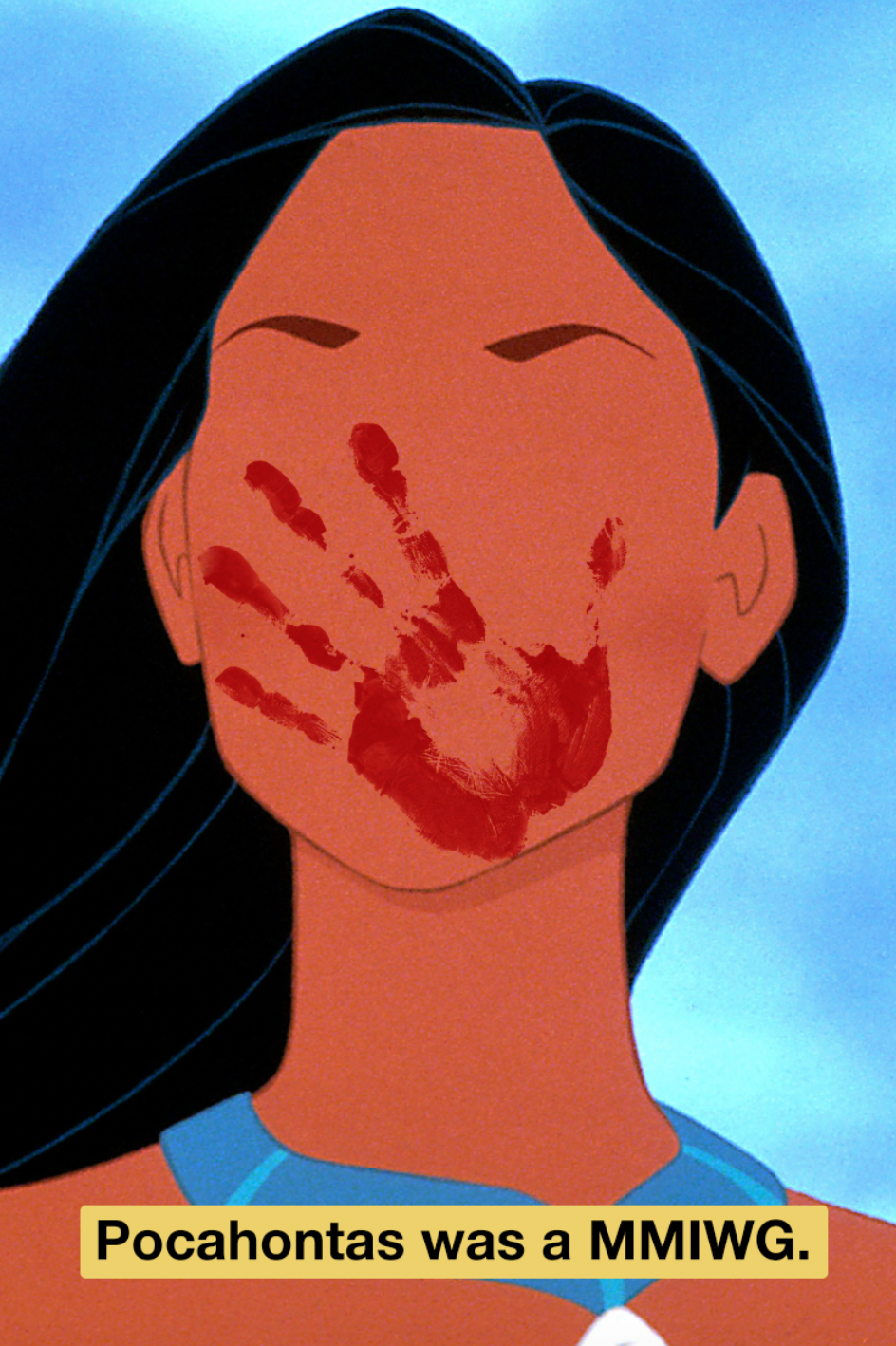The True Story Behind Disney’s Pocahontas
Contrary to Disney’s portrayal of this well-known ‘family film,’ the true story of Pocahontas is not one of a romance, but a tragedy. Pocahontas was one of the first real-life Missing and Murdered Indigenous Women (MMIW).
Historical Inaccuracies and Whitewashing:
While many may know this historical figure as Pocahontas, to family and those around her, she was known by different names. Her primary name at birth was Amonute, and her secondary name was Matoaka, meaning “flower between two streams.” The heartbreaking life of Pocahontas was one of tragedy and violence - the story of a young girl who was brutally raped, kidnapped, and allegedly murdered by those who were meant to keep her safe.
Disney’s version of Pocahontas centers John Smith, the man Pocahontas supposedly fell in love with. In reality, John Smith came to her town when she was only 9 or 10 years old, while he was 27 years old. Despite Disney’s narrative, the two were never romantically involved. In fact, John Smith was feared by many Indigenous children in the area he was in, and was known to enter villages and hold various chiefs of tribes at gunpoint, demanding food and supplies.
Violence Against Indigenous Women and Girls
The early 1600’s were an incredibly dangerous time period for tribes near Werowocomoco, including Pocahontas’ tribe. When English colonizers arrived in Werowocomoco, they began targeting women and young children, and began sexually assaulting Indigenous girls. Many planned to kidnap Pocahontas, as she was the chief’s daughter. When she was only 15 or 16, the threat of possible kidnapping increased. Sadly, Matoaka ended up being kidnapped and was forced to give up her first child. Her husband, Kocoum, whom she had only been married to recently before, was killed by those who kidnapped her. An English colonist, Captain Samuel Argall sought to find her, thinking that a captured daughter of the chief would prevent attacks from certain Indigenous tribes. Argall threatened the chief that if he didn't relent, he would attack the village. He also told the chief that Pocahontas would only be gone temporarily. This was a promise he quickly broke.
The disregard white colonists had for Indigenous peoples was shown when Argall, (prior to leaving), gave the chief a pot made of copper, and claimed he traded it for Pocahontas. This essentially meant he equated the value of her life and freedom to that of a copper pot. Prior to leaving her village, Pocahontas had to give her baby (known as little Kocoum) to the women of the village. “Trapped onboard an English ship, she was not aware that when her husband returned to their village, he was killed by the colonists” (Indian Country Today).
Upon being kidnapped, Pocahontas was brought to England. During this time, she was allegedly raped and abused by her English captors. Later on, she gave birth to another son, Thomas. She was eventually converted to Christianity, and her name was changed to Rebecca.
Due to the atrocities committed by white settlers against Indigenous peoples, there were many English individuals who disapproved and were against the injustices that Indigenous groups endured at the hands of colonization. As a result, Pocahontas was brought to England as a political symbol, a show of peace between English settlers and Indigenous groups. “According to the accounts of Mattachanna, she realized that she was being used and desperately desired to return home to her father and little Kocoum. During her travels in England, Pocahontas did meet John Smith and expressed outrage due to the mistreatment of his position as leader of the colonists and the betrayal to the Powhatan people” (Indian Country Today). Some time after the journey was made, Pocahontas was set to return to her home in the Spring of 1617. At the time, Pocahontas was perfectly healthy and in good condition to return, according to accounts by Mattachanna. However, shortly after having dinner along with John Rolfe and her Argall, she vomited and died. She had not even turned 21 at the time of her death, and despite her family requesting that her body be laid to rest in her tribe, Rolfe and Argall brought her to Gravesend in England where she was buried at a church. Her father was heartbroken at the news after having learned from Mattachanna that his daughter had died. He ended up dying from grief less than a year after Pocahontas.
Disney’s Romanticization of Pocahontas
When comparing the portrayal of Pocahontas through Disney’s lens as opposed to the accurate historical accounts, there is a stark difference. Not only has Disney inaccurately portrayed the life of Pocahontas - they have also romanticized her life, and in extension, sugarcoated the trauma Indigenous peoples faced through colonization. The life of Pocahontas was filled with sorrow and is not one that should be seen as a love story. The romanization of Pocahontas’ life is extremely problematic, as it veils many of the harsh realities Indigenous peoples faced at the time. The true story of Pocahontas strays far from her seemingly perfect life.
Works cited:
Mansky, Jackie, and Jacqueline Mansky. “The True Story of Pocahontas | History.” Smithsonian Magazine, 23 March 2017, https://www.smithsonianmag.com/history/true-story-pocahontas-180962649/. Accessed 31 March 2022.
Schilling, Vincent. “The True Story of Pocahontas: Historical Myths Versus Sad Reality.” Indian Country Today, 16 February 2017, https://indiancountrytoday.com/archive/true-story-pocahontas-historical-myths-versus-sad-reality. Accessed 31 March 2022.
Pocahontas was a MMIW.
Artwork by Meera Baswan

